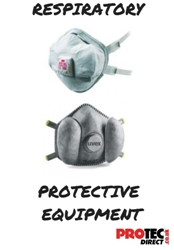Respiratory protective equipment, what do I need

Unseen danger
There are many working environments that come with hazards and risks. Some are more obvious than others. Working with hazardous substances, extreme heat, at heights, or on construction sites have their obvious dangers but it is often the dangers that we cannot see that pose the biggest risks.
Substances that contaminate the air and get into our lungs can cause short-term, long-term, chronic and even fatal damage and we may never even know it is happening to us, until it’s too late.
Causes
Workers who cut materials such as wood and stone, or who work on dusty construction sites may be inhaling silica, non-silica and wood dust. This can sit on the lungs, causing silicosis, cancer and asthma.
Volatile solvents, mists and vapours are also potentially very dangerous, as is handling any kind of powder or even welding. Any of the above combined with confined spaces can create a recipe for serious illness.
Choosing the correct RPE
In order to select the appropriate RPE, you need to assess the risks and hazards of any working environment. There are a number of different types of RPE for different circumstances. You need to make sure that it is both adequate (enough to protect the wearer against hazards) and suitable (the correct size, shape and allowing sufficient freedom of movement).
Respirators are used to remove contaminants from the air before breathing. These can either be powered, using a motor to pass air through the filter, or non-powered, using the power of inhalation to drag air through the filter.
Breathing apparatus supply air from a different source altogether, and can be used against a range of airborne hazards and in may different atmospheres. These will usually be powered or pressurised in some way to aid breathing.
Facepieces for both RPE and breathing apparatus are either tight- or loose-fitting. The use of either depends on the quality of air around the user but loose-fitting masks in general are only used with powered RPE and breathing apparatus.
The law of the UK states that employers are legally responsible for providing this equipment and carrying out all the necessary assessments before use. They also need to ensure that all equipment is suitable and in good working order.
The dangers of dust, fumes and other respiratory hazards are very real in the workplace. The Health and Safety Executive estimates that last year 500 people died as a direct result from inhaling dust and fumes at work, with a further 4,000 more fatalities having strong links to respiratory issues.
You can never be too careful, so always make sure you are using the correct equipment at all times.
Comments
Latest Blogs

An updated guide by consumer organization Which? looks at how to protect people’s ears. They focus on two main types of ear protection, earplugs and ear defenders.

A review submitted by the Department of Work and Pensions (DWP) has recommended that the Health and Safety Executive (HSE) should compel employers to improve their behaviour in issues of workplace health and safety.

Drivers are being urged to consider their footwear choices when behind the wheel, particularly during hot summer days when flip-flops are popular.

Leave a comment